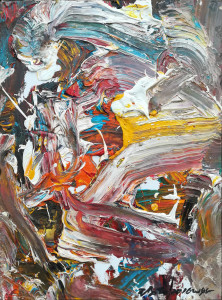Opening Reception: Thursday, November 8th, 6-8 pm
52 E. 76th Street, New York, NY 10021
(212) 439-6425, katherine@borghi.org
Gallery hours are Monday- Friday, 10 am to 5 pm
Wang Yigang: Recent Works
November 8, 2018– December 21, 2018
-

ABSTRACT S36, 2016, oil on canvas, 31 1/2 x 23 5/8 inches
Mark Borghi Fine Art is pleased to announce a solo exhibition, featuring fourteen paintings by the Chinese abstract expressionist artist Wang Yigang from the 1990s to 2016. Born in 1961 in Qiqihar, China, Wang Yigang is one of the first generation of Chinese artists who turned to western art influence and took up abstract painting after China’s ten-year cultural revolution and close-off from the outside world.
In the 1970s and 80s, China started to build diplomatic relations with the U.S. and many other western countries, while at the same time initiated economic reforms that resulted in the famous 8% annual GDP growth economic phenomenon that lasted more than two decades. Information about western culture and society and global commodities started to flood into China and the entire generation of Chinese young artists suddenly got exposure to modern western philosophy, art, and music. It was during this particularly flourishing period that Wang received his formal art education at the Luxun Academy of Fine Arts and graduated with a degree in oil painting in 1986.
Luxun Academy of Fine Arts was first established by Mao in 1938 with a clear goal to cultivate China’s own artists who can paint both politically correct and highly skilled paintings. This changed in late 1970s and early 1980s, when artists and artistic institutes turned its back to earlier Soviet realist style and ideological influence and sought out Cubism, Abstract Art, Expressionism, and Pop Art as their new sources of inspiration.
Wang participated in the seminal group show “National Art Exhibition of the Young Artists” at China Art Museum in Beijing in 1985, the same year that Robert Rauschenberg was exhibited for the first time in China. This exhibition initiated the “Eighty-Five New Wave,” an art movement that includes almost every art expression that Chinese artists started to explore in the 1980s. For Wang, to create abstract oil paintings is to express freely and to prove his very own existence. In other words, abstract art is a lifestyle and way of thinking. Its spirit in individual expression of personal experience and existence, according to Wang, is not just a visual language and style, but also a culture that exerts great influence on post-Mao Chinese artists, including himself.
Wang categorizes his three decades of painting career into four main phases. His first attempt on abstract painting during the 1990s primarily absorbed the visual language of American Abstract Expressionism, which can be demonstrated by ABSTRACT N19, the only painting from the 1990s in this exhibition. (Figure 1) Created with a vibrant palette, ABSTRACT N19 emphasizes the tension and freedom that one would seem within the seemingly chaos. Some of the brushworks in black and red also have a graffiti flair, which led to his second phase that demonstrates influence from Pop Art. Wang’s “Qianjiang” series in early 2000s translates a traditional Chinese ink wash technique into oil painting, displaying landscape motifs imbedded in thick and versatile oil brush works. As demonstrated by LANDSCAPE Y22, 2014, works from this series are able to display a unique tension between the highly textured oil painting surface in the lower portion and the almost atmospheric poetic “mountain scene” carried out with traditional Chinese ink wash technique. (Figure 2)
The majority paintings of this exhibition came from Wang’s most recent practices. He calls these works “conceptual abstraction,” as they are the products of his “subconscious creative process.“ His emphasis on a spiritual spontaneity that almost “announces knowledge and culture,” captures the artist’s force of creativity and personal will power.
Wang had exhibited internationally throughout his career. A retrospective exhibition of his paintings was organized by the Today Museum in Shanghai, 2010. The artist currently lives in Shenyang, China, and teaches at the Luxun Academy of Fine Arts.
The reception will take place on Thursday, November 8th, 6-8pm, 52 East 76th Street, New York, NY 10021. The exhibition is on view through Friday, December 21st, 2018. Gallery hours are Monday – Friday, 10am to 5pm. Gallery closed between Dec. 4th-Dec.10th for Art Miami. For additional information, please contact the gallery at (212) 439-6425 or email katherine@borghi.org.
